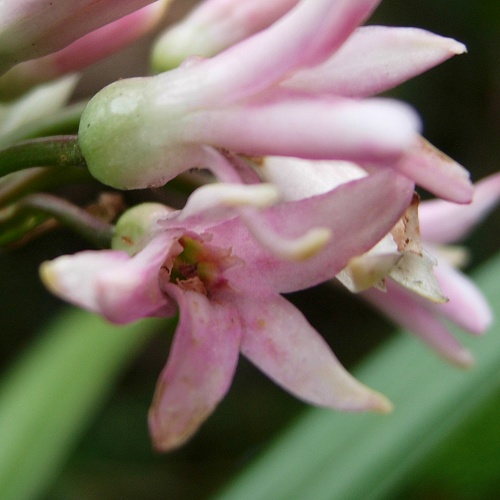Germinating the seeds
When to plant -- Plant your seeds promptly for the best results. Getting started -- Start by soaking them in a cup of water for 24 hours (not more than 48 hours). Pot size - You may use small pots about 3 or 4 inches tall (7-10 cm) and 2 to 3 inches (5-8 cm) wide. The pots need drainage holes. Use well-draining soil. I use a mix of 1 part
coir fiber Fill the pots with the soil mix, place a seed on top, and cover with about 1/4 inch (7 mm) of soil. Add water until evenly moist (but not fully saturated). Until they sprout, ensure that the surface soil stays moist. I don't recommend placing the pots in a plastic container to maintain moisture. Temperature -- Aim to keep them between 65 and 78° F (18-26°C) during the day, and a little cooler at night (60-74°F
= 16-23°C). I have no experience outside this temperature range. I
recommend placing a
minimum/maximum thermometer Keep them in a bright spot out of direct sun. The seeds will sprout at different times, with most of them sprouting between 1 and 3 months. The germination rate with fresh seeds is high, so be patient with any slow ones. Lighting the seedlings -- Once your seeds sprout, keep them in a bright spot, with protection from afternoon sun. A bright LED or fluorescent bulb kept 4 inches (10 cm) away provides the right amount of light (See: "Growing indoors with LED lights"). Watering: Once they are 4 weeks old, you may allow the surface soil to dry out between waterings, but aim to keep the rest of the soil evenly moist most of the time. Never let it dry out completely, but also don't keep it constantly saturated. If your seedlings happens to rise out of the soil and the root becomes exposed, simply pile a little soil around the root. Growing on... Climate -- It has similar cultural requirements as Clivia, growing best in mild temperatures with cool nights. I don't have information on how much heat it can take, but it's possible that it won't thrive if temperatures consistently get above 85 degrees F (29 degrees C) with nights above 65 degrees F (18 C). Over about 40-45% humidity is best. Lighting -- It likes filtered sun or morning sun. Protect it from strong afternoon sun. Fertilizing -- The first 2 months, feed every 7 days with a small amount of dilute (1/8 strength) liquid fertilizer. Hydroponic fertilizer is ideal for young seedlings, because it is easily absorbed and complete. After 2 months, you may switch to granular fertilizer that contains micronutrients. Repotting -- Once your seedlings are 2 months old, you may repot them to larger containers about 1 quart (1 liter) in size. For soil, use a loose growing medium, similar to what is used for growing Clivia. A typical mix is 1 part fine bark, 1 part potting soil or compost, and 1 part perlite, pumice, or coarse horticultural sand. Mix in some granular fertilizer. After 12-18 months, repot them to a 1-2 gallon (4-8 liter) container, which can hold them indefinitely. Repotting mature plants may delay flowering. If you have any questions, feel free to contact me. Have fun growing them! - Jeff Strange Wonderful Things
|
|||||||||


